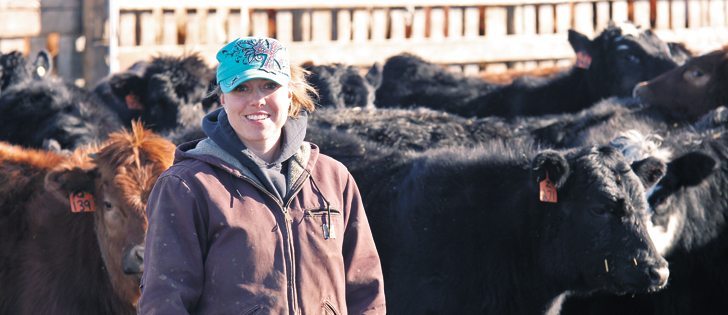CORONATION, Alta. — Meagan Schwenk-Gattey doesn’t think of her cattle as livestock.
To her, they’re “her girls.”
As Schwenk-Gattey wanders through her 500-head herd or her 1,500-head feedlot, she can rattle off a cow’s breeding, point out its sister, look around to find its calves and know which cows produce calves with high weaning weights.
“Cattle have always been my love,” she said.
She joined her local 4-H club when she was nine with a steer and heifer project. By the time she graduated from high school, she had the start of a herd that she now runs with her husband, Brandon Gattey, a local John Deere mechanic.
Read Also

Farming Smarter receives financial boost from Alberta government for potato research
Farming Smarter near Lethbridge got a boost to its research equipment, thanks to the Alberta government’s increase in funding for research associations.
At 14, Schwenk-Gattey helped her mother, Deena, pick replacement heifers and by 18 was deciding which herd bulls to buy.
Her father Phil’s only request was to make sure the bull would throw calves with a good rate of gain and be sound enough to carry through to slaughter in the family’s Bigview Stock Farm feedlot.
The family had a Charolais, Fleckvieh, Simmental and Hereford cross herd at the time, but Schwenk-Gattey preferred Black Simmentals and bought the first of a long line of bulls from that breed, which now makes up the basis of the herd.
Her eye for good genetics, combined with a strong feeding program developed by her father and brother, Levi, means the steers and heifers are sent to slaughter by 13 months.
“It’s been the result of a good breeding program.”
In 2011, she won the Alberta Simmental Association’s commercial Simmental cow herd of the year award.
Schwenk-Gattey credits her parents for allowing her love of livestock to become a career.
Not everyone is as open about a woman running the farm’s livestock business.
When she was younger, Schwenk-Gattey would phone a supplier and her father would get called back with the answer.
“I moved our farm business from some businesses because they didn’t want to deal with me.”
Now 28, Schwenk-Gattey has solid credentials, backed by quality cattle, and she rarely has to deal with people who don’t like dealing with women.
“It’s a totally different game than when I was 18 or 20,” she said. “I am now working with great people who want to work with me. They’re really supportive and helpful.”
She tried buying her own feedlot steers at the auction market for a couple years but eventually gave up and contracted it out to an order buyer.
“It was easier to ride pens. I don’t want to sit in an auction all day.”
Schwenk-Gattey took a disease course while studying at Lakeland College that really resonated. After returning to the farm, she decided to work with the local veterinarian to create a herd health program, which has eliminated almost any sickness in the herd.
Outside steers bought for the feedlot are kept separate from the farm-raised steers and heifers for the first four months to reduce disease. She logs every treatment and sick animal into a computer.
Having access to high speed internet to record cattle weights and herd health is key. The farm eventually added high speed internet to the processing barn to ensure that data entry didn’t slow that task.
“We’re not going to be held up by a computer program,” she said.
Information is entered into the herd program connected to Schwenk-Gattey’s cell phone when cattle are born, weighed and treated.
“It’s essential,” she said.
“We don’t always have a pen and paper. If you enter it in, then it’s done and it’s accurate.”
Studying herd genetics and cattle data, such as what the farm receives from Cargill, has helped build a uniform herd.
Only a handful of outside heifers and cows have entered the herd in 10 years.
“I now feel the cows are a proper quality,” she said.
She calls her heifers thick, beefy and curvaceous.
Calving is set for March and April, and the family hopes only a few cows will be left to calve during the busy spring seeding season.
The entire family is kept busy driving equipment during seeding and harvest. They often chat by satellite phone while in the field, and everyone listened to the Toronto Blue Jays’ exciting playoff run last fall.
“That was intense radio.”
Schwenk-Gattey knows one other young female livestock operator who is as actively in-volved in the farm business as she is. Together they discuss genetics, bounce ideas off each other and have a good cry together when times are tough.
“Cows mean a lot to us,” she said.
“Every decision I make with the cow herd is on me.”
If she picks a hard calving bull, she’s the one up at night pulling calves.
As the key person looking after the farm’s livestock, Schwenk-Gattey hopes she can be a role model for other young women in agriculture.
“Women just need the support,” she said.

















